Google Drive vs IDrive: A Cloud Collaboration Cocktail for 2025
Google Drive is one of the best cloud storage services, while IDrive tops our best online backup rankings. See how they compare in this Google Drive vs IDrive matchup.
Google Drive is among the best cloud storage services around, while IDrive proudly tops our best online backup rankings. At first glance, seeing as how storage and backup are very different things, there doesn’t seem to be much to base a Google Drive vs IDrive comparison on.
However, looks can be deceiving, and in this piece we will be discussing how and when these two services swim into each others’ waters, as well as which one does the best job for your needs.
Generally speaking, though, you can safely assume that IDrive is your best bet when it comes to cloud backup, while Google Drive is your go-to when you want to work with others online.
In some specific instances, you may be surprised at how well these two services function outside of their respective bailiwicks. As such, we recommend you take the winner and loser of each round — as well as the piece overall — with a grain of salt and keep your personal situation in mind before acting on our opinions.
-
07/03/2022
Updated to reflect an increase in IDrive’s free plan to 10GB of storage.
-
05/23/2023
Updated to remove IDrive’s discontinued free plan.
Setting Up A Battle: Google Drive vs IDrive
With these disclaimers out of the way, let’s get to the good stuff. We’ve divided this piece into five rounds, which reflect some of the areas that Google Drive and IDrive share. If you’d rather see more complete pictures of these two providers individually, definitely check out our IDrive review and Google Drive review instead.
- 1
- :
- :
- :
- :
- :
- :
- :
- 2
1. Backup
As we mentioned in the introduction, IDrive is the undisputed champion of backup compared to other providers in the field, so Google Drive has no chance in this round and is left whimpering in IDrive’s dust from the start. However, let’s look at exactly how IDrive whups its competition.
IDrive Backup
IDrive offers more features than any other provider, with the possible exception of Acronis Cyber Protect Home Office, and it can backup all manner of devices and operating systems.
So no matter what you’re rocking — Windows desktop, Apple Macbook, NAS, external hard drive, you name it — you can back it up with IDrive. It also supports unlimited devices, so no matter if you have two or 20, you can use IDrive for them all.
The only exception is anything running on Linux. Members of Team Penguin will want to check out our best cloud backup for Linux article instead.
When it comes to backing up your files, you can do so in several ways: on the level of individual files or — if you’re more the set-it-and-forget-it type — on the level of folders or even entire disks.
In fact, IDrive pre-selects a bunch of folders for you so you don’t even have to go over it yourself if you don’t want to. In case you encounter any issues, refer to our guide on how to fix an IDrive backup failure.
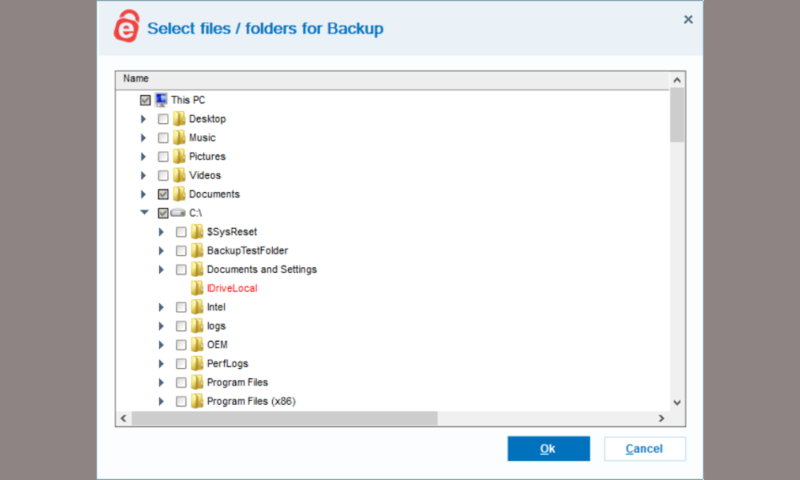
Though IDrive’s speeds are decent enough in and of themselves, the service also supports block-level file copying. This means it scans all files before uploading and then only transfers the bits that have been changed, which saves you both time and resources.
Google Backup & Sync
Compare all this to how you can use Google Drive as a backup provider and, well, you probably see the issue. While Google’s Backup and Sync works well enough, it just doesn’t pack the same punch as IDrive does and offers far fewer options. That said, it’s a great way to backup your files for free, so we won’t discount it altogether.
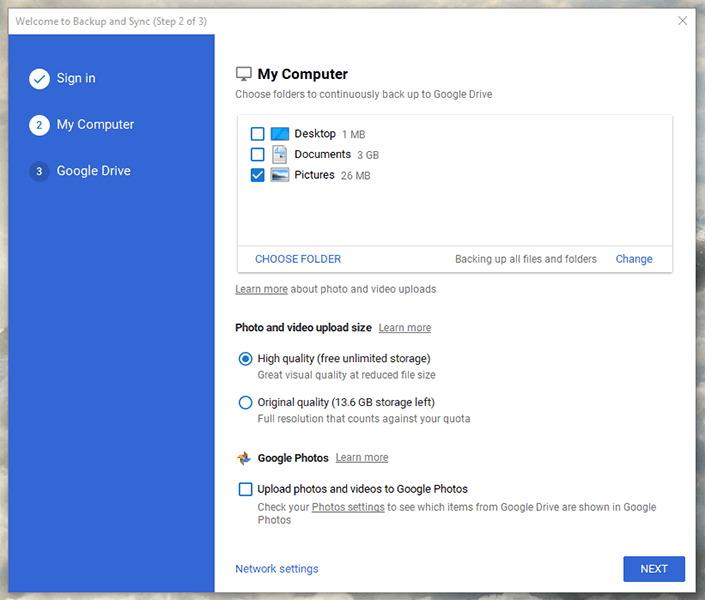
In fact, if you just need to backup a few files, Google Drive is better, as it offers 15GB for free. However, once you go over that 15 gigs, Google’s advantage is gone. On the other hand, IDrive offers 10GB of free storage. That’s less than Google Drive, but again, if there’s just a few files you need to store, it’ll do the job.
IDrive offers 5TB for $69.65 per year at its lowest tier, which is a lot better than the $100 Google charges annually for less than half the amount of storage space. If you prefer to pay per month, the ratio stays roughly the same.
To sum up, if you have less than 15GB worth of files that you need backed up and you don’t need too many options when sending them into the cloud, Google Drive is an OK backup alternative if you’re not too demanding. Anything beyond that, IDrive is the service you want.
2. Syncing Files
With one point decisively awarded to IDrive, let’s go to a round where Google Drive has the upper hand. IDrive offers some pretty decent syncing abilities, but it’s no match for Google in this area. The challenger from Mountain View simply has more to offer.
Google Drive is one of the best syncing solutions out there, with only pCloud and Sync.com beating it in this regard. What this means, in layman’s terms, is that any file you have linked on either your computer or in the cloud changes across all devices when you mess with a single copy. It’s an incredibly handy feature and IDrive is one of the few backup services that has it.
Admittedly, IDrive’s syncing abilities are a cut above even those of many storage providers, though Dropbox outperforms it in this category, as you can read in our IDrive vs Dropbox comparison. There’s also no cap on the file size, making IDrive a great way to send large files.
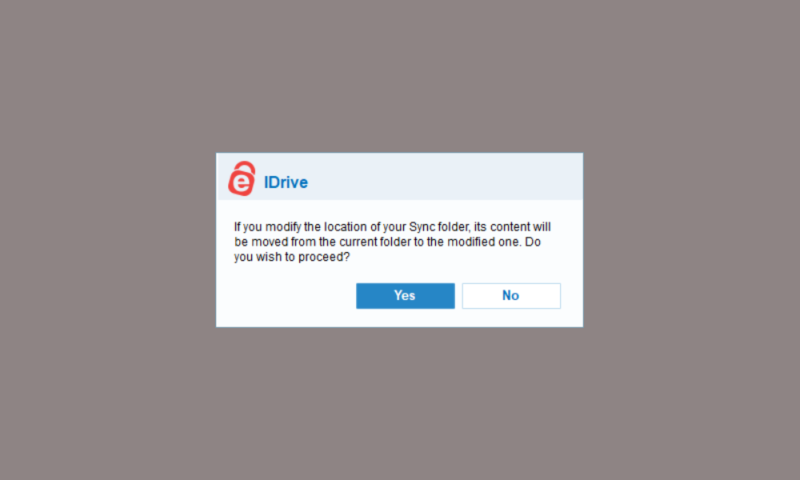
However, Google Drive just does a better job. It lets you sync files from every device imaginable, sometimes even sweeping up files you had no intention of moving into the cloud. (We’ll admit that’s rather annoying.)
It also packs in a number of its apps into this process, most notably Google Photos, which uploads every pic you take into the cloud, earning it second place in our best online storage for photos ranking.
Besides pictures, Google also syncs docs and spreadsheets, and it can even sync files other people are working on. If you want to have an idea how to prevent automatic syncs, check out our piece on how to stop Google Drive sync. Taken altogether, IDrive’s sync, while pretty good, just can’t hold a candle to Google Drive’s.
3. Sharing & Collaboration
We’re entering our third round now, and both contenders are neck and neck, with one point each. However, Google Drive is about to take the advantage as we discuss sharing and collaboration functions, where it reigns supreme.

While IDrive can share files, it’s basically just a glorified transfer service. Google Drive can share, collaborate in real time and do a host of other things, making it our second pick for the best cloud storage service for collaboration. Although it’s not perfect, it’s a fantastic overall tool and probably the best alternative for people who don’t want to shell out for a full EFSS solution.
Sharing with Google Drive is easy, and it offers a lot more options than IDrive does, including the option to restrict people from certain content as well as to share files across a whole organization. Add to that the ability to actually work in real time on the files you’ll be sending, and you have yourself a winner.
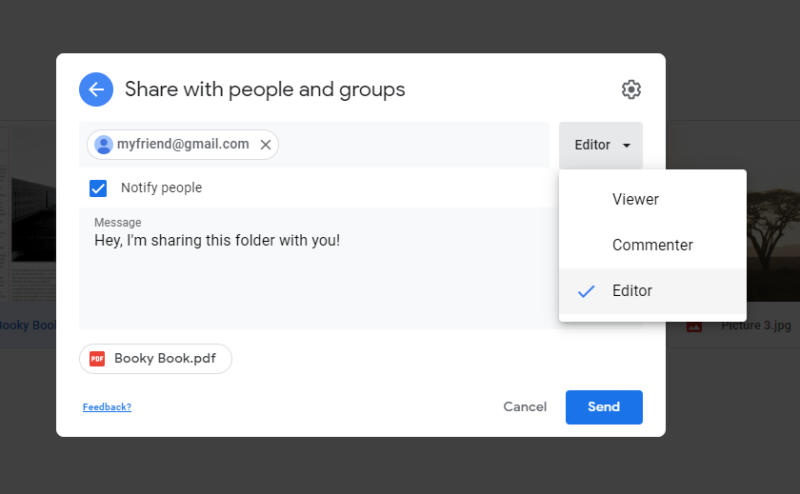
We go over the details of how to work with Google Drive in both our review and in this guide, but in short, Drive offers everything you could need from a basic productivity suite: a word processor, a spreadsheet program, a presentation maker and a number of smaller bits and bobs.
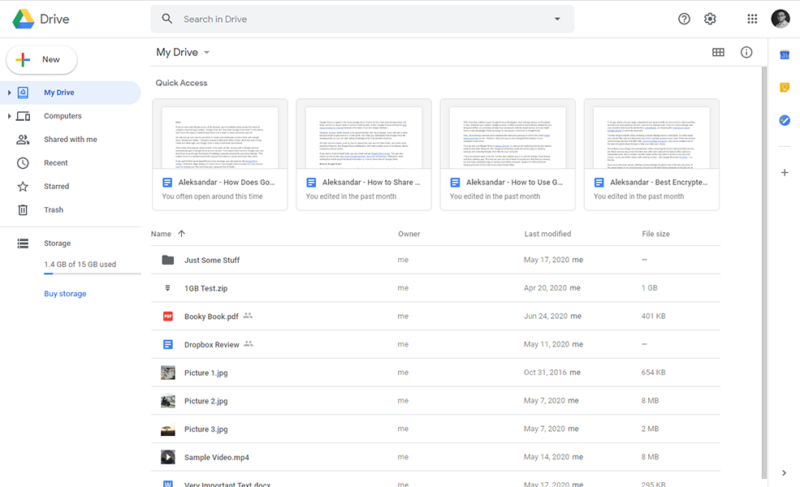
Though none of these applications are winners by themselves, when bundled all together for free, they make a great suite for most people and a great competitor to Microsoft Office — we use Google Drive here at Cloudwards thanks to its amazing versatility. As IDrive has nothing of the sort, this round automatically goes to Google Drive.
4. Security
With all the easier rounds out of the way, let’s move into more contested territory: security. We’ll start with how well each service protects your files from outside meddling, before finishing up with a round on privacy and how well each service protects you from itself.
When it comes to the way IDrive and Google Drive protect your files, there doesn’t seem to be too much of a difference at first. Both use the now-standard AES-256 cipher during transfer. This is perfectly secure, meaning nobody will be cracking the security on your files that way unless they have a few billion years to spare.
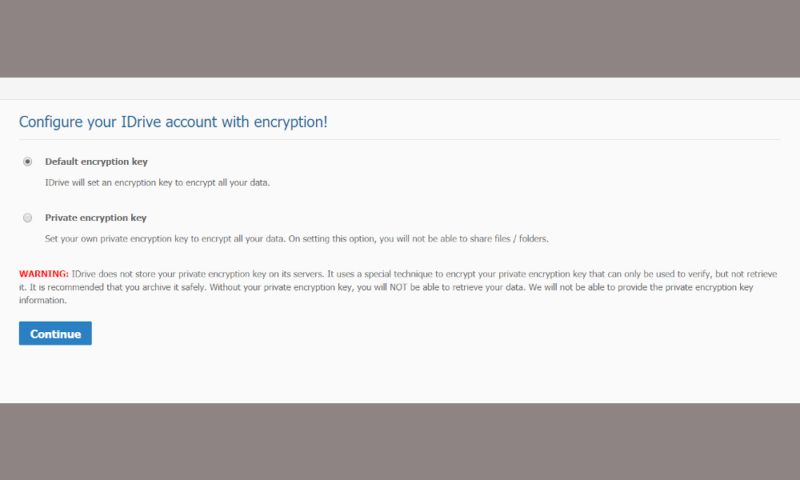
Other important features that our two contenders share are at-rest encryption, two-factor authentication and secure data centers. Google especially does not mess around with protecting its data centers, though IDrive’s physical security is nothing to sneeze at.
Although both encrypt your files at rest, Google goes with 128-bit AES, while IDrive uses 256-bit. That’s not a huge difference, though it might disqualify Google Drive for the very security conscious.
However, a bigger issue is that IDrive allows you to use zero-knowledge encryption (you need to turn it on yourself, and it disables sharing capabilities, which is a bummer), while Google does not — as you can read in our Google Drive security guide.
This deficiency makes your files vulnerable to mischief by Google’s employees (more on that in the next section), but also to third parties if they were ever able to gain access to where Google stores its users’ passwords. While your files may be impervious to cracking, if an attacker were able to somehow steal your password from Google, they could just walk right on in.
While this last scenario is a bit of a nightmare and hasn’t happened to Google yet, its slightly weaker at-rest encryption makes us give the round to IDrive, even if just by a hair.
5. Privacy
So far, the battle has been a close one, with IDrive and Google Drive being neck and neck with two points each, but this last round goes easily to IDrive.
As a company that makes most of its money from ads, Google has a terrible privacy policy and will actively scan your Drive files to find out more about you. IDrive doesn’t do this, so it’s automatically the winner here.
Of course, there’s a little more to it than that, so let’s go over the main points. IDrive will likely be the darling of people worried about their privacy, with a privacy policy that’s fully compliant with the EU’s GDPR regulations as well as the U.S. healthcare rules enshrined in HIPAA.
However, do note that IDrive’s servers are located in the States, meaning that if you’ve been naughty and the authorities present a warrant, IDrive will hand over your files. Then again, if you switch on zero-knowledge encryption, you should be alright in this case, as IDrive might hand over your files, but not your password as it doesn’t have access to it.
Google and Privacy
The above may sound a bit iffy, but considering the way Google handles your private data, it’s pretty much a no-brainer. When you use Google services — be it search, Google Photos or Drive — you’re pretty much giving the company full access to your devices.
Google gladly makes use of it, too. There are many revelations concerning the way Google uses data from users’ private files and devices, so we won’t bore you with more details here. Just assume that if you’ve written something in Google, it has been assimilated into some matrix or another.
That said, as far as anybody can tell, your data is anonymized, so it’s not like anybody knows that you were looking up some weird porn, just that somebody did. Even so, it’s hard to shake the mental image of a Google employee looking at all your files in real time.
Google doesn’t use zero-knowledge encryption, so we generally recommend that you don’t store sensitive data on Google’s servers unless you enable it yourself using some of the best encryption software, like Cryptomator.
However, no matter how you slice it, IDrive has a lot more built-in privacy, so it ultimately takes the cake without any real argument.
The Verdict
There you have it, a 3-2 decision for IDrive; though, as we said in the introduction, we were comparing apples to oranges a bit. While using IDrive as a cloud storage provider is a bit silly, using Google Drive as anything more than a rudimentary backup service isn’t the best way to go, either.
Instead, we’d recommend you use IDrive as the backup for all your important and sensitive files, while keeping Google Drive around for archiving files and online collaboration. By mixing a little IDrive-and-Google Drive cocktail like this, you should be covered from every angle while getting the best of both worlds.
What do you think of our IDrive vs Google Drive conclusion? Is IDrive the best backup service or do you think Google does a better job here? How about Google’s productivity suite? Is it any good? Let us know your thoughts on these and other matters in the comments below. As always, thank you for reading.

